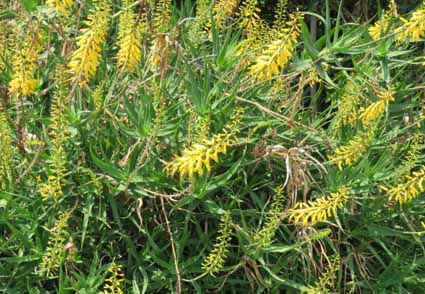Abstract
A red- and several yellow-flowered variants of Aloiampelos tenuior (Asphodelaceae subfam. Alooideae), a species of scrambling aloe, are well known, including in cultivation, and apart from the autonymic variety, at least four others have been given taxonomic recognition at that rank. The yellow-flowered varieties of A. tenuior are predominantly, but not exclusively, based on vegetative characters, while the red-flowered variety is distinguished by its flower colour, as well as vegetative characters. The orange-flowered form of A. tenuior, which is much less common in cultivation than A. tenuior var. tenuior or A. tenuior var. rubriflora, is here described as A. tenuior var. ernstii.
References
<p align="justify"><span style="color: #000000;"><span style="font-family: Times New Roman, serif;"><span style="font-size: small;">Carter, S., Lavranos, J.J., Newton, L.E. & Walker, C.C. (2011) Aloes. The definitive guide. Kew Publishing, Royal Botanic Gardens, Kew / British Cactus & Succulent Society, London, 719 pp.</span></span></span>
<p align="justify"><span style="color: #000000;"><span style="font-family: Times New Roman, serif;"><span style="font-size: small;">Ellis, K. (2013) Revision of Aloiampelos Klopper & Gideon F.Sm. (Xanthorrhoeaceae subfam. Asphodeloideae). Unpublished M.Sc. thesis. Nelson Mandela [Metropolitan] University, Port Elizabeth [now Gqeberha], 126 pp.</span></span></span>
<p align="justify"><span style="color: #000000;"><span style="font-family: Times New Roman, serif;"><span style="font-size: small;">Glen, H.F. & Hardy, D.S. (2000) Aloaceae (First part): Aloe. In: G. Germishuizen (ed.) Flora of southern Africa Vol. 5, Part 1, Fasc. 1. National Botanical Institute, Pretoria, pp. 1–167.</span></span></span>
<p align="justify"><span style="color: #000000;"><span style="font-family: Times New Roman, serif;"><span style="font-size: small;">Grace, O.M., Klopper, R.R., Figueiredo, E. & Smith, G.F. (2011) The aloe names book. Strelitzia 28. South African National Biodiversity Institute, Pretoria and the Royal Botanic Gardens, Kew, 232 pp. [https://hdl.handle.net/20.500.12143/270]</span></span></span>
<p align="justify"><span style="color: #000000;"><span style="font-family: Times New Roman, serif;"><span style="font-size: small;">Grace, O.M., Klopper, R.R., Smith, G.F., Crouch, N.R., Figueiredo, E., Rønsted, N. & Van Wyk, A.E. (2013) A revised generic classification for Aloe (Xanthorrhoeaceae subfam. Asphodeloideae). Phytotaxa 76: 7–14. https://doi.org/10.11646/phytotaxa.76.1.2</span></span></span>
<p align="justify"><span style="color: #000000;"><span style="font-family: Times New Roman, serif;"><span style="font-size: small;">Haworth, A.H. (1825 [06 July]) XLIV. Decas quinta novarum Plantarum Succulentarum (“Mr Haworth’s Fifth Decade of new Succulent Plants.”). The Philosophical Magazine and Journal 66 (Issue 330): 279–283. https://doi.org/10.1080/14786442508673967</span></span></span>
<p align="justify"><span style="color: #000000;"><span style="font-family: Times New Roman, serif;"><span style="font-size: small;">IPNI. (2022 [continuously updated]) The International Plant Names Index. Available from: https://www.ipni.org/ (accessed August 2022).</span></span></span>
<p align="justify"><span style="color: #000000;"><span style="font-family: Times New Roman, serif;"><span style="font-size: small;">Jeppe, B. (1969) South African aloes. Purnell & Sons S.A. (Pty) Ltd, Cape Town, Johannesburg, London, 144 pp.</span></span></span>
<p align="justify"><span style="color: #000000;"><span style="font-family: Times New Roman, serif;"><span style="font-size: small;">Klopper, R.R. & Smith, G.F. (2017) Aloiampelos Klopper & Gideon F.Sm. Family: Asphodelaceae (Asphodelaceae). Internet. 10 pp. [https://pza.sanbi.org/aloiampelos]</span></span></span>
<p align="justify"><span style="color: #000000;"><span style="font-family: Times New Roman, serif;"><span style="font-size: small;">Linnaeus, C. (1753) Species plantarum, exhibentes plantas rite cognitas, ad generarelatas, cum differentiis specificis, nominibus trivialibus, synonymis selectis, locis natalibus, secundum systema sexuale digestas. Vol. 1. Salvius, Stockholm, 560 pp. [Aloe L. treated on pp. 319–323]. https://doi.org/10.5962/bhl.title.669</span></span></span>
<p align="justify"><span style="color: #000000;"><span style="font-family: Times New Roman, serif;"><span style="font-size: small;">Reynolds, G.W. (1936) Aloe tenuior Haw. A revision of the species, with descriptions of two new varieties (with Plates XI–XII). Journal of South African Botany 2: 105–112. [https://archive.org/details/journalofsouthaf02unse/page/104/mode/2up]</span></span></span>
<p align="justify"><span style="color: #000000;"><span style="font-family: Times New Roman, serif;"><span style="font-size: small;">Reynolds, G.W. (1950 [December]) The aloes of South Africa. The Trustees, The Aloes of South Africa Book Fund, Johannesburg, 520 pp.</span></span></span>
<p align="justify"><span style="color: #000000;"><span style="font-family: Times New Roman, serif;"><span style="font-size: small;">Smith, G.F. & Figueiredo, E. (2015) Garden aloes. Growing and breeding cultivars and hybrids. Jacana Media (Pty), Ltd, Auckland Park, Johannesburg, xiv, 193 pp.</span></span></span>
<p align="justify"><span style="color: #000000;"><span style="font-family: Times New Roman, serif;"><span style="font-size: small;">Smith, G.F., Figueiredo, E., Klopper, R.R., Crouch, N.R. & Walker, C.C. (2021) Aloiampelos ciliaris var. ciliaris. Asphodelaceae: Alooideae. South Africa. Flowering Plants of Africa 67: 18–30, plate 2362.</span></span></span>
<p align="justify"><span style="color: #000000;"><span style="font-family: Times New Roman, serif;"><span style="font-size: small;">Thiers, B. (2022 [continuously updated]) Index herbariorum: a global directory of public herbaria and associated staff. New York Botanical Garden’s Virtual Herbarium. Available from: http://sweetgum.nybg.org/ih/ (accessed August 2022).</span></span></span>
<p align="justify"><span style="color: #000000;"><span style="font-family: Times New Roman, serif;"><span style="font-size: small;">Turland, N.J., Wiersema, J.H., Barrie, F.R., Greuter, W., Hawksworth, D.L., Herendeen, P.S., Knapp, S., Kusber, W.-H., Li, D.-Z., Marhold, K., May, T.W., McNeill, J., Monro, A.M., Prado, J., Price, M.J. & Smith, G.F. (2018) International Code of Nomenclature for algae, fungi, and plants (Shenzhen Code) adopted by the Nineteenth International Botanical Congress Shenzhen, China, July 2017. Koeltz Botanical Books, Glashütten. [Regnum Vegetabile 159], 254 pp. https://doi.org/10.12705/Code.2018</span></span></span>
<p align="justify"><span style="color: #000000;"><span style="font-family: Times New Roman, serif;"><span style="font-size: small;">Van Jaarsveld, E.J. (2007) Aloe tenuior var. viridifolia, a new variety (series Fruticosae) from the Eastern Cape, South Africa. Aloe 44 (3): 60–62.</span></span></span>
<p align="justify"><span style="color: #000000;"><span style="font-family: Times New Roman, serif;"><span style="font-size: small;">Van Jaarsveld, E.J. (2021) Aloiampelos tenuior var. viridifolia. Asphodelaceae. South Africa. Flowering Plants of Africa 67: 32–40, plate 2363.</span></span></span>
<p align="justify"><span style="color: #000000;"><span style="font-family: Times New Roman, serif;"><span style="font-size: small;">Van Wyk, B.-E. & Smith, G.F. (2014) Guide to the aloes of South Africa. 3<sup>rd</sup> edition. Briza Publications, Queenswood, Pretoria, 376 pp.</span></span></span>
<p align="justify"><span style="color: #000000;"><span style="font-family: Times New Roman, serif;"><span style="font-size: small;">Verdoorn, I.C. (1961) Aloe tenuior. Flowering Plants of Africa 34: t. 1352.</span></span></span>


